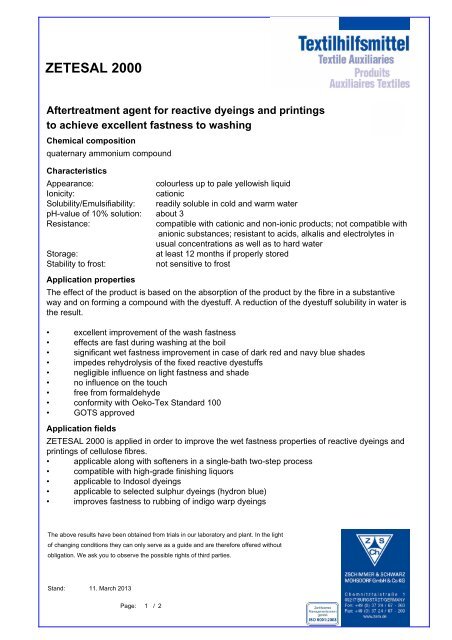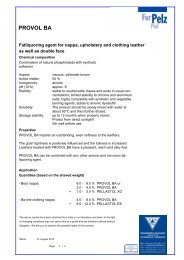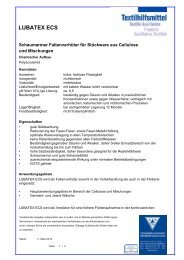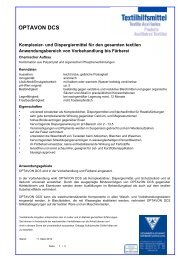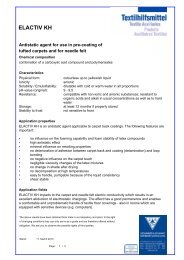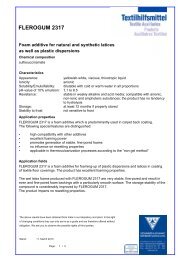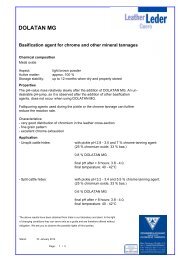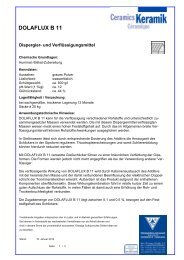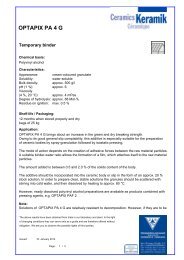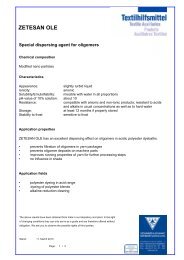ZETESAL 2000 - Zschimmer & Schwarz
ZETESAL 2000 - Zschimmer & Schwarz
ZETESAL 2000 - Zschimmer & Schwarz
You also want an ePaper? Increase the reach of your titles
YUMPU automatically turns print PDFs into web optimized ePapers that Google loves.
<strong>ZETESAL</strong> <strong>2000</strong>Aftertreatment agent for reactive dyeings and printingsto achieve excellent fastness to washingChemical compositionquaternary ammonium compoundCharacteristicsAppearance:colourless up to pale yellowish liquidIonicity:cationicSolubility/Emulsifiability: readily soluble in cold and warm waterpH-value of 10% solution: about 3Resistance:compatible with cationic and non-ionic products; not compatible withanionic substances; resistant to acids, alkalis and electrolytes inusual concentrations as well as to hard waterStorage:at least 12 months if properly storedStability to frost:not sensitive to frostApplication propertiesThe effect of the product is based on the absorption of the product by the fibre in a substantiveway and on forming a compound with the dyestuff. A reduction of the dyestuff solubility in water isthe result.• excellent improvement of the wash fastness• effects are fast during washing at the boil• significant wet fastness improvement in case of dark red and navy blue shades• impedes rehydrolysis of the fixed reactive dyestuffs• negligible influence on light fastness and shade• no influence on the touch• free from formaldehyde• conformity with Oeko-Tex Standard 100• GOTS approvedApplication fields<strong>ZETESAL</strong> <strong>2000</strong> is applied in order to improve the wet fastness properties of reactive dyeings andprintings of cellulose fibres.• applicable along with softeners in a single-bath two-step process• compatible with high-grade finishing liquors• applicable to Indosol dyeings• applicable to selected sulphur dyeings (hydron blue)• improves fastness to rubbing of indigo warp dyeingsThe above results have been obtained from trials in our laboratory and plant. In the lightof changing conditions they can only serve as a guide and are therefore offered withoutobligation. We ask you to observe the possible rights of third parties.Stand:11. March 2013Page:1 / 2
<strong>ZETESAL</strong> <strong>2000</strong>Guidelines for applicationThe product shall be diluted before adding it to the aftertreatment bath. Stock solutions remain stableover a longer period of time. Dilute <strong>ZETESAL</strong> <strong>2000</strong> with cold water.Exhaust process: 0.5 – 4.0% <strong>ZETESAL</strong> <strong>2000</strong>The aftertreatment is carried out for 20 minutes at 40 - 50°C within the pH range of 5 to 6.Continuous process:5 – 30 g/l <strong>ZETESAL</strong> <strong>2000</strong> by paddingThe impregnating liquor is to be adjusted to a pH value of 5 to 6.CORRECTION OF FAULTY DYEINGS:Stripping of <strong>ZETESAL</strong> <strong>2000</strong> for overdyeing and shading3 g/l SETAVIN CO2 – 3 ml/l formic acid 85%treatment 30 min at 90 °C, rinse, neutralize, overdye and treat with <strong>ZETESAL</strong> <strong>2000</strong> againCorrection of unlevel dyeings1. Stripping of <strong>ZETESAL</strong> <strong>2000</strong>3 g/l SETAVIN CO2 – 3 ml/l formic acid 85%treatment 30 min at 90 °C, rinse, neutralize2. Stripping of dye in accordance with the instructions of dyestuff manufacturersThe above results have been obtained from trials in our laboratory and plant. In the lightof changing conditions they can only serve as a guide and are therefore offered withoutobligation. We ask you to observe the possible rights of third parties.Stand:11. March 2013Page:2 / 2


